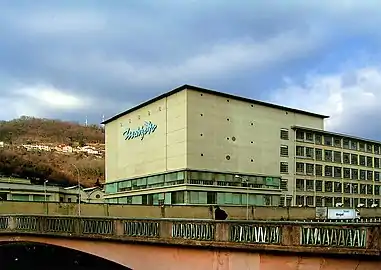Marzotto
The Marzotto Group is an Italian textile manufacturer, based in Valdagno.
| Industry | Textile |
|---|---|
| Founded | 1836 |
| Headquarters | Valdagno , Italy |
Key people | Antonio Favrin (president) |
| Revenue | 356.8 mil Euro (2018) |
Number of employees | 3,245 (2018) |
| Website | www.marzottogroup.it |
Created in 1836 as the Lanificio Luigi Marzotto & Figli. In 2005 Marzotto Group's textile business separated from Valentino Fashion Group.
The Group manufactures woollen and cotton yarns for clothing, and through equity investments, woollen yarns for knitwear, linen yarns and silk.
Brands
The Group manufactures in textile sector with the brands:
- Marzotto
- Estethia - G.B. Conte
- Guabello
- Marlane
- Fratelli Tallia di Delfino
- Tessuti di Sondrio
- Nuova Tessilbrenta
- Redaelli Velluti
- Lanerossi Blankets
In the linen yarns sector, Marzotto Group manufactures through the Linificio e Canapificio Nazionale of which the parent company owns 100% of the ordinary shares.
History

Luigi Marzotto founded a wool mill in Valdagno in 1836, but handed the business to his son Gaetano, Sr. in 1842. After the unification of the kingdom of Italy in 1861, Gaetano took advantage of the company's location (companies in northeast Italy were found to make the transition from an agrarian to an industrial economy more quickly than those in the south) by buying a spinning factory nearby Maglione. By then, the company's payroll had risen to over 1.200 employees.
After Gaetano's death in 1910, Marzotto S.p.A. split in two, so his son Gaetano, Jr. took over the Maglione factory and his grandson Vittorio Emanuele Marzotto, who has been credited with leading the company into the export business, took over the Valdagno operations. In the 1950s, Marzotto S.p.A. diversified in the manufacturing of private-label menswear, Principe by Marzotto. After going public in 1961 with a listing on the Borsa Italiana, the Milan exchange market, the company started exporting its products to the United States. To reduce labour costs, 40 percent of the clothing production would eventually be transferred there.
In the 1980s and 1990s, more and more companies were bought by Marzotto S.p.A.: Lanerossi in 1987, whose addition made Marzotto Europe's first fully integrated wool producer, Hugo Boss in 1991 and Czechoslovakia’s Nová Mosilana wool mill in 1994. The company's grandest move came in 1997, when it announced that it would merge with HPI to form Gruppo Industriale Marzotto, the world's largest designer clothing manufacturer. However, in May of that year, Pietro Marzotto (son of Vittorio Emanuele, so great-great-grandson of Luigi), abruptly stopped negotiations, which led to Pietro's resignation of his function as chief executive and the take-over by Jean de Jaeger, the first non-Marzotto to be promoted to such a function. Pietro nonetheless remained the majority shareholder of Marzotto S.p.A. and he purchased Liteksas, a Lithuanian wool garments manufacturer, in 2000, so that the company could shift part of its production to the lower-cost market. He also bought Valentino S.p.A., which had been struggling under HPI, in 2003, and the company has seen surging profits and gaining sales ever since.
References
External links
- Official website
- Marzotto treccani.it